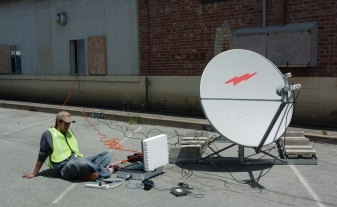Tech Specs: Specifics on WIISARD System Set-up
By Maureen C. Curran
|
Moffet Field, NASA AMES, CA, May 6, 2006 -- Researchers from Calit2's WIISARD project successfully demonstrated their mass-casualty patient tracking system and accomplished a couple of 'firsts' when they participated in the California EMS Authority's Rough and Ready emergency preparedness exercise on Saturday May 6.
(For more information on WIISARD's participation in the Rough and Ready, please see the related article, click on title: Calit2 WIISARD Researchers Demonstrate That They Are 'Rough and Ready.')
WIISARD's mass-casualty tracking, triage and medical information management system combines state-of-the-art data collection and display devices, database services, and 802.11 wireless communications to produce a consistent, real-time view of the disaster scene. It was initially designed for work with the Metropolitan Medical Strike Teams (MMST), in situations where victims are contaminated by chemical or radiological weapons, or other areas where MMST teams might be involved.
|
The first step is the creation of a wireless 802.11 mesh network across the disaster site (using CalMesh and a satellite dish). GPS units attached to it enable estimation of people's position using signal strength triangulation. Developed by the ResponSphere project at Calit2, CalMesh is an ad-hoc network of small, lightweight, and easily reconfigurable nodes that quickly self-organize to form a reliable wireless mesh network. Eight to 10 nodes were deployed, all inside the hangar, except one which was outside to support the satellite dish.
After the wireless network is deployed, there are three levels of equipment: electronic patient tags, hand-held devices and a tablet system. The hand-held devices and tablet systems are based on off-the-shelf equipment which has been modified and reconfigured. A command center system on a laptop computer provides an overview of the area, summaries of casualties, counts and other activities.
|
Patient/Victim tags. First responders in the triage areas are given electronic tags to use (one per patient). They are able to enter the triage status of that patient on the tag; it will be recorded on the tag and also transmitted to the system's central database for tracking of that victim. Flashing triage lights correspond to the triage status assigned; the tag hangs around the neck of the patient. When the patients are transported, the triage tags will carry the electronic medical record of what has happened at the site with the patient.
Hand-held devices . These PDA-like units are given to the first responders who can use them to enter reports of physical exam findings or treatments. Each one is equipped with a barcode scanner to accurately identify medications and accurately link patients with specific medication doses. Triage personnel can also enter additional patients with this device. The information is available and accessible to all other facets of the disaster response.
Mid Tier tablet system. This system allows supervisors to manage care in specific areas and allows people to assign victims to a specific transport option. For example, at the Rough and Ready drill it was used to indicate when people were supposed to be loaded onto the C-130 aircraft. The midtier unit and database are sent with the patients and used for assignment to hospitals and ambulances at the destination reception sites.
Related Links
Additional Technical Information
Rough & Ready photo gallery
Related Articles
Calit2 WIISARD Researchers Demonstrate That They Are 'Rough and Ready'
Related Projects
Wireless Internet Information System for Medical Response in Disasters




